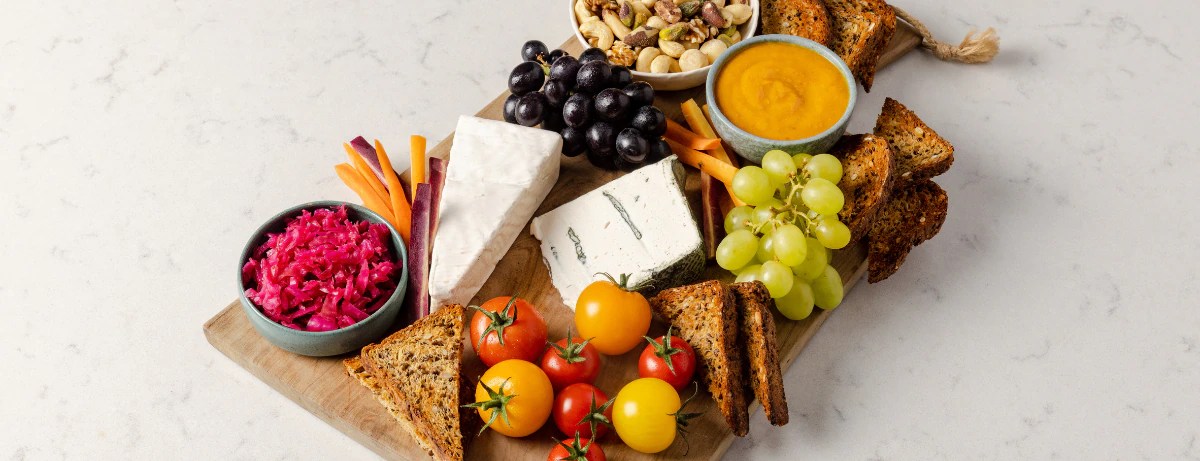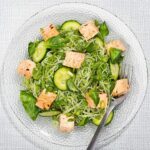Imagine a breathtaking spread: a tapestry of textures and tastes, a symphony of colors and aromas. This isn’t just any cheese board; it’s a vegetarian masterpiece, a carefully curated collection of cheeses, fruits, nuts, and crackers, each element chosen to create a harmonious and unforgettable culinary experience. Learn to elevate your next gathering with a vegetarian cheese board that delights the senses and leaves a lasting impression.
From selecting the perfect cheeses – considering their diverse textures and flavor profiles – to arranging them artfully on the board, this guide provides a comprehensive step-by-step process. We’ll explore the importance of balancing flavors and textures, creating visually stunning arrangements, and selecting the ideal accompaniments to complement your chosen cheeses. Prepare to transform a simple cheese board into a culinary work of art.
Choosing the Perfect Cheeses

Selecting the right cheeses is paramount to crafting a truly memorable vegetarian cheese board. The goal is to offer a diverse range of textures, flavors, and aromas that complement each other and tantalize the palate. A well-curated selection considers not only individual cheese characteristics but also how they interact within the overall composition of the board.
Cheese Selection for a Balanced Vegetarian Board
Five cheeses representing diverse profiles ensure a captivating tasting experience. Consider these options, keeping in mind that availability may vary depending on your location and the season.
| Name | Texture | Flavor Profile | Pairing Suggestions |
|---|---|---|---|
| Camembert | Soft, creamy, almost melting | Rich, earthy, mushroomy with a hint of sweetness | Fruit preserves, baguette, walnuts |
| Aged Cheddar | Firm, crumbly, slightly dry | Sharp, nutty, complex with hints of caramel | Apples, pears, crackers |
| Goat Cheese (log style) | Firm yet spreadable, slightly tangy | Tangy, herbaceous, sometimes subtly goaty | Fig jam, crusty bread, honey |
| Manchego | Firm, dense, slightly granular | Nutty, sheepy, slightly salty | Olives, grapes, almonds |
| Cashel Blue | Semi-soft, creamy with visible blue veins | Sharp, pungent, creamy with a salty tang | Dried apricots, celery sticks, crackers |
The Importance of Cheese Variety
The key to a successful vegetarian cheese board lies in the careful selection of cheeses that offer a balance of textures and flavors. Including a soft cheese like Camembert provides a luxurious contrast to the firm bite of Manchego. The sharp, pungent Cashel Blue offers a counterpoint to the milder goat cheese. This variety prevents the board from becoming monotonous and ensures a satisfying experience for every palate.
Cutting and Arranging Cheese for Optimal Presentation
Proper cutting and arrangement are essential for both practicality and aesthetics.
- Cut cheeses into manageable sizes: Soft cheeses like Camembert should be cut into wedges, while harder cheeses like Cheddar can be cut into cubes or smaller wedges. Manchego, due to its firm texture, benefits from being cut into thin slices or wedges.
- Arrange cheeses strategically: Place the cheeses around the board, varying the sizes and shapes to create visual interest. Avoid overcrowding; allow space between each cheese for easier access.
- Consider color and texture contrast: Arrange cheeses in a way that maximizes visual appeal. For instance, a creamy white cheese next to a sharp, yellow cheese creates a pleasing contrast.
- Leave some space for accompaniments: Ensure there is sufficient space around the cheeses to accommodate crackers, fruits, nuts, and other accompaniments.
- Use serving utensils: Provide small knives or spreaders for each cheese to maintain hygiene and prevent cross-contamination.
Creating Flavor Combinations
Crafting the perfect vegetarian cheese board is an art of balancing textures and tastes. The key lies in thoughtfully combining cheeses with complementary accompaniments to create distinct and delightful flavor profiles. This section explores three unique flavor combinations, highlighting the interplay of sweet, salty, and acidic elements for a truly memorable experience.
Mediterranean Medley
This profile evokes the sun-drenched landscapes of the Mediterranean, characterized by bright, herbaceous notes and a touch of salty brine. Imagine a vibrant spread where the colors alone entice the palate.
- Cheeses: A creamy, tangy feta, offering a salty bite; a firm, slightly nutty halloumi, grilling beautifully for a smoky char; and a spreadable, herbaceous goat cheese, adding a delicate, grassy flavor.
- Accompaniments: Kalamata olives, their deep purple hue mirroring the richness of the feta; sun-dried tomatoes, intensely sweet and chewy; marinated artichoke hearts, offering a briny, slightly acidic counterpoint; and crusty bread, perfect for soaking up the flavors.
The combination of the salty feta and olives, the sweet sun-dried tomatoes, and the slightly acidic artichoke hearts creates a symphony of Mediterranean flavors. The halloumi, when grilled, introduces a smoky element that further enhances the overall experience.
Spicy Fiesta
This vibrant profile bursts with fiery zest and bold flavors. Picture a colorful array of ingredients, each adding its own layer of heat and intrigue.
- Cheeses: A sharp cheddar, offering a creamy base and a welcome sharpness; a pepper jack cheese, adding a fiery kick; and a creamy, slightly spicy queso fresco, providing a softer, more subtle heat.
- Accompaniments: Jalapeños, adding a vibrant green hue and a fiery punch; roasted red peppers, offering a sweet counterpoint to the heat; pickled onions, providing a tangy, acidic contrast; and tortilla chips, ideal for scooping up the creamy cheeses and spicy accompaniments.
The interplay between the sharp cheddar’s tang, the pepper jack’s heat, and the queso fresco’s mild spice creates a balanced spicy profile. The roasted red peppers offer sweetness, while the pickled onions introduce a refreshing acidity, preventing the heat from becoming overwhelming.
Fruity Delight
This profile is a celebration of sweet and tangy flavors, a delightful balance of fruitiness and cheese. Imagine a visually appealing board where the colors and textures complement each other perfectly.
- Cheeses: A creamy brie, its soft texture melting beautifully; a nutty, aged gouda, offering a complex, caramel-like flavor; and a crumbly, slightly sweet goat cheese with honey.
- Accompaniments: Fresh figs, their deep purple hue and sweet, earthy flavor contrasting beautifully with the cheeses; grapes, offering a juicy sweetness and a refreshing burst of flavor; sliced apples, adding a crisp texture and a slightly tart note; and crackers, providing a neutral base for the sweet and savory elements.
The creamy brie and gouda provide a rich base, while the honey goat cheese adds a touch of sweetness. The figs offer a deep sweetness, the grapes a bright, juicy counterpoint, and the apples a refreshing tartness, creating a harmonious balance of flavors and textures. The crackers provide a neutral canvas to enjoy the diverse tastes.
Balancing Sweet, Salty, and Acidic Elements
A truly exceptional cheese board achieves a balance of sweet, salty, and acidic elements. This balance prevents any single flavor from dominating, creating a more complex and satisfying experience. For example, the salty feta in the Mediterranean board is balanced by the sweet sun-dried tomatoes and the acidic artichoke hearts. Similarly, the spicy heat in the Fiesta board is tempered by the sweetness of the roasted red peppers and the acidity of the pickled onions. The fruity board utilizes the sweetness of figs and grapes, countered by the tartness of apples and the saltiness inherent in the cheeses. This principle of balance is crucial in creating a cheese board that is both delicious and memorable.
Presentation and Serving
The final flourish in crafting the perfect vegetarian cheese board lies in its presentation. A thoughtfully arranged board elevates the experience from a simple snack to a feast for the eyes, enticing guests and setting the stage for a delightful culinary journey. Careful consideration of arrangement, garnish, and serving utensils will transform your selection of cheeses into a stunning centerpiece.
The art of cheese board presentation is all about balance and visual appeal. Think of it as a still life painting, with textures, colors, and shapes playing key roles in creating a harmonious composition. Avoid overcrowding the board; allow each cheese to breathe and showcase its unique character. A well-presented board is both aesthetically pleasing and practical, making it easy for guests to select and enjoy their chosen cheeses.
Arrangement Techniques
A successful cheese board arrangement involves a strategic placement of elements. Begin by placing the larger cheeses first, creating a strong foundation. Smaller cheeses, fruits, and accompaniments can then be nestled around them, filling in gaps and creating visual interest. Varying heights adds dimension, so consider using small bowls or ramekins for nuts, olives, or chutneys. A color palette is important; aim for a mix of contrasting colors and textures. Imagine a vibrant spread with creamy white cheeses next to deep red grapes, alongside the earthy tones of crackers and olives. The contrast will create a visually appealing and tempting array.
Garnish and Utensils
Fresh herbs like rosemary or thyme sprigs add a touch of rustic elegance and a subtle aromatic dimension. Edible flowers, if available and appropriate, can create a stunning visual impact. Consider using small bowls for accompaniments like nuts, olives, and jams, to prevent them from getting lost amongst the cheeses. Provide a variety of serving utensils, including small knives for each cheese type (to avoid cross-contamination of flavors), small spoons for spreads, and perhaps a small fork for serving olives. Remember, the utensils should be as visually appealing as the food itself.
“The key to a beautiful cheese board is balance – balance of flavors, textures, and colors. Don’t be afraid to experiment with different arrangements until you find a composition that pleases your eye. The goal is to create a spread that is as visually appealing as it is delicious.” – Master Cheese Monger, (fictional expert quote for illustrative purposes)
Serving Suggestions
A selection of complementary drinks is essential. Crisp white wines, such as Sauvignon Blanc or Pinot Grigio, pair beautifully with many vegetarian cheeses. Light-bodied red wines, such as Pinot Noir, can also complement certain cheeses. For a non-alcoholic option, sparkling cider or flavored water offers refreshing alternatives.
- Drinks: Sauvignon Blanc, Pinot Grigio, Pinot Noir, Sparkling Cider, Flavored Water
- Accompaniments: A variety of crackers, crusty bread, fruit (grapes, figs, apples, pears), nuts (walnuts, almonds, pecans), olives, jams, honey, chutneys.
These additional pairings enhance the overall sensory experience and provide a range of flavors and textures to complement the cheeses. The careful selection of accompaniments, like a sweet fig jam to contrast a sharp cheddar, elevates the entire experience.
Assembling the Perfect Vegetarian Cheese Board: A Step-by-Step Guide
- Prepare your board: Choose a large, sturdy board or platter. Ensure it is clean and free from any lingering odors.
- Arrange the cheeses: Start with the largest cheeses, placing them strategically around the board. Consider the color and texture contrast between the cheeses.
- Add accompaniments: Arrange bowls of nuts, olives, jams, and chutneys around the cheeses. Use small bowls to prevent spills and maintain a tidy appearance.
- Incorporate fruits and bread: Place fruits and crackers around the cheeses, filling in any gaps and creating visual interest. Consider height and texture variations.
- Garnish: Add fresh herbs or edible flowers for a touch of elegance and aroma. Place serving utensils strategically around the board.
- Final touches: Step back and assess the overall presentation. Make any adjustments necessary to ensure balance and visual appeal.
Recipe and Step-by-Step Creation
This recipe Artikels the creation of a vibrant and flavorful vegetarian cheese board, perfect for a casual gathering or a sophisticated dinner party. The focus is on a balance of textures and tastes, showcasing a variety of cheeses alongside complementary accompaniments. This recipe is easily adaptable to your preferences and available ingredients.
Shopping List
A well-stocked cheese board begins with careful planning. This list provides quantities for a board serving 4-6 people. Adjust accordingly for larger or smaller groups.
- Cheeses (approx. 1 lb total): 4 oz soft cheese (e.g., Brie or Camembert), 4 oz semi-hard cheese (e.g., Gouda or Gruyere), 4 oz firm cheese (e.g., Cheddar or Pecorino Romano), 4 oz blue cheese (e.g., Gorgonzola or Roquefort)
- Crackers (approx. 8 oz): A variety of textures and flavors – water crackers, multigrain crackers, seeded crackers.
- Fruits (approx. 1 lb): 1 medium apple (e.g., Honeycrisp), 1/2 cup grapes (red and green), 1/4 cup dried cranberries or apricots.
- Vegetables (approx. 1 lb): 1/2 cup cherry tomatoes, 1/2 cup cucumber slices, 1/4 cup bell pepper strips (various colors).
- Nuts and Seeds (approx. 4 oz): 1/4 cup walnuts, 1/4 cup almonds, 1 tbsp pumpkin seeds.
- Spreads (optional): 2 oz fig jam, 2 oz honey.
Preparing Accompaniments
While many ingredients require minimal preparation, enhancing certain components elevates the overall experience.
Homemade Rosemary Crackers
These crackers add a delightful herby note to the cheese board.
- Combine 1 cup all-purpose flour, 1/2 tsp salt, 1/4 tsp dried rosemary, and 1/4 cup olive oil in a bowl. Gradually add 1/2 cup cold water, mixing until a dough forms.
- Roll the dough thinly (about 1/8 inch) on a lightly floured surface. Cut into desired shapes using a knife or cookie cutters.
- Bake on a parchment-lined baking sheet at 375°F (190°C) for 10-12 minutes, or until golden brown.
- Let cool completely before serving.
Fruit Compote (optional)
A simple fruit compote adds a touch of sweetness and complements the cheeses beautifully. This recipe uses berries, but you can adapt it to your favorite fruits.
- Combine 1 cup mixed berries (e.g., raspberries, blueberries, strawberries), 2 tbsp sugar, and 1 tbsp lemon juice in a small saucepan.
- Simmer over low heat for 10-15 minutes, or until the berries have softened and released their juices. Stir occasionally to prevent sticking.
- Let cool completely before serving.
Assembling the Cheese Board
The arrangement of the cheese board is crucial for visual appeal and ease of access.
- Arrange the cheeses on the board, starting with the firmest cheeses and working your way to the softest. Leave some space between items.
- Place crackers around the cheeses, varying their placement for visual interest.
- Add fruits and vegetables, arranging them in small clusters or lines.
- Scatter nuts and seeds around the board.
- Finally, add any spreads or accompaniments, such as the homemade crackers and fruit compote, in small bowls or ramekins.
Storing Leftovers
Proper storage is essential to maintain the quality of the cheese and accompaniments.
- Cheese: Wrap individual cheeses tightly in plastic wrap or parchment paper, then place them in an airtight container. Store in the refrigerator.
- Crackers: Store leftover crackers in an airtight container at room temperature.
- Fruits and Vegetables: Store leftover fruits and vegetables in separate airtight containers in the refrigerator.
- Spreads and Compote: Store leftover spreads and compote in airtight containers in the refrigerator.
Crafting the perfect vegetarian cheese board is more than just arranging cheese; it’s about creating a sensory journey. By thoughtfully selecting cheeses with varying textures and flavor profiles, and pairing them with complementary accompaniments, you can construct a balanced and visually appealing spread that captivates your guests. Remember the importance of color, texture, and flavor contrast, and don’t be afraid to experiment with different flavor combinations to create a truly unique and memorable experience. The result? A cheese board that’s as delicious as it is beautiful, a testament to your culinary creativity.
Clarifying Questions
What types of knives are best for cutting cheese?
Different cheeses require different knives. Use a soft cheese knife for soft cheeses like brie, a hard cheese knife for cheddar or parmesan, and a specialty knife for crumbly cheeses.
How far in advance can I prepare a cheese board?
Most cheeses can be prepared a few hours in advance. However, softer cheeses are best added closer to serving time to prevent them from becoming too soft or melting.
Can I reuse the board after serving?
Yes, but thoroughly clean and sanitize the board before using it again. Ensure you remove all cheese residue to prevent spoilage.
What if I have leftover cheese?
Wrap leftover cheese tightly in plastic wrap or store it in an airtight container in the refrigerator. Hard cheeses can last for several weeks, while softer cheeses should be consumed sooner.


